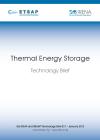

Thermal energy storage: Technology brief
This technology brief provides technical background information, analyses market potential and barriers, and offers insights for policy makers on thermal energy storage.
Newsletter
Energy storage systems are designed to accumulate energy when production exceeds demand, and to make it available at the user’s request. They can help to match energy supply and demand, exploit variable renewable (solar and wind) energy sources, increase the overall efficiency of the energy system and reduce carbon-dioxide emissions.
This brief deals primarily with heat storage systems or thermal energy storage (TES), a technology that stocks thermal energy by heating or cooling a storage medium, so that the stored energy can be used later, either for heating and cooling applications or for power generation. TES systems are used particularly in buildings and industrial processes. With these applications, approximately half of the energy consumed comes in the form of thermal energy, the demand for which can vary within the day and from one day to the next.
TES systems can help balance energy demand and supply on a daily, weekly and even seasonal basis. They can also reduce peak demand, energy consumption, emissions and costs, while increasing overall system efficiency. The conversion and storage of solar and wind energy helps to further increase the share of renewables in the energy mix. TES is becoming particularly important for electricity storage in combination with concentrating solar power (CSP), whereby solar heat can be stored for electricity production when sunlight is not available.
Successive technology briefs have highlighted a wide range of renewable energy solutions. Each brief outlines technical aspects, costs, market potential and barriers, combined with insights for policy makers on how to accelerate the transition to renewables.
This brief deals primarily with heat storage systems or thermal energy storage (TES), a technology that stocks thermal energy by heating or cooling a storage medium, so that the stored energy can be used later, either for heating and cooling applications or for power generation. TES systems are used particularly in buildings and industrial processes. With these applications, approximately half of the energy consumed comes in the form of thermal energy, the demand for which can vary within the day and from one day to the next.
TES systems can help balance energy demand and supply on a daily, weekly and even seasonal basis. They can also reduce peak demand, energy consumption, emissions and costs, while increasing overall system efficiency. The conversion and storage of solar and wind energy helps to further increase the share of renewables in the energy mix. TES is becoming particularly important for electricity storage in combination with concentrating solar power (CSP), whereby solar heat can be stored for electricity production when sunlight is not available.
Successive technology briefs have highlighted a wide range of renewable energy solutions. Each brief outlines technical aspects, costs, market potential and barriers, combined with insights for policy makers on how to accelerate the transition to renewables.




